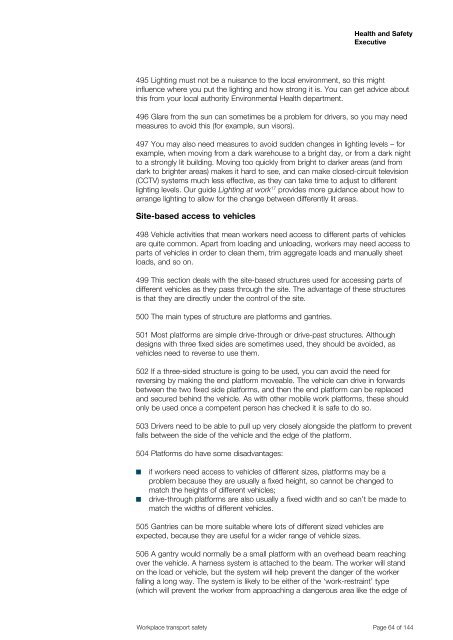Workplace transport safety An employers' guide - ARRI Lighting Rental
Workplace transport safety An employers' guide - ARRI Lighting Rental
Workplace transport safety An employers' guide - ARRI Lighting Rental
Create successful ePaper yourself
Turn your PDF publications into a flip-book with our unique Google optimized e-Paper software.
Health and Safety<br />
Executive<br />
495 <strong>Lighting</strong> must not be a nuisance to the local environment, so this might<br />
influence where you put the lighting and how strong it is. You can get advice about<br />
this from your local authority Environmental Health department.<br />
496 Glare from the sun can sometimes be a problem for drivers, so you may need<br />
measures to avoid this (for example, sun visors).<br />
497 You may also need measures to avoid sudden changes in lighting levels – for<br />
example, when moving from a dark warehouse to a bright day, or from a dark night<br />
to a strongly lit building. Moving too quickly from bright to darker areas (and from<br />
dark to brighter areas) makes it hard to see, and can make closed-circuit television<br />
(CCTV) systems much less effective, as they can take time to adjust to different<br />
lighting levels. Our <strong>guide</strong> <strong>Lighting</strong> at work 17 provides more guidance about how to<br />
arrange lighting to allow for the change between differently lit areas.<br />
Site-based access to vehicles<br />
498 Vehicle activities that mean workers need access to different parts of vehicles<br />
are quite common. Apart from loading and unloading, workers may need access to<br />
parts of vehicles in order to clean them, trim aggregate loads and manually sheet<br />
loads, and so on.<br />
499 This section deals with the site-based structures used for accessing parts of<br />
different vehicles as they pass through the site. The advantage of these structures<br />
is that they are directly under the control of the site.<br />
500 The main types of structure are platforms and gantries.<br />
501 Most platforms are simple drive-through or drive-past structures. Although<br />
designs with three fixed sides are sometimes used, they should be avoided, as<br />
vehicles need to reverse to use them.<br />
502 If a three-sided structure is going to be used, you can avoid the need for<br />
reversing by making the end platform moveable. The vehicle can drive in forwards<br />
between the two fixed side platforms, and then the end platform can be replaced<br />
and secured behind the vehicle. As with other mobile work platforms, these should<br />
only be used once a competent person has checked it is safe to do so.<br />
503 Drivers need to be able to pull up very closely alongside the platform to prevent<br />
falls between the side of the vehicle and the edge of the platform.<br />
504 Platforms do have some disadvantages:<br />
n if workers need access to vehicles of different sizes, platforms may be a<br />
problem because they are usually a fixed height, so cannot be changed to<br />
match the heights of different vehicles;<br />
n drive-through platforms are also usually a fixed width and so can’t be made to<br />
match the widths of different vehicles.<br />
505 Gantries can be more suitable where lots of different sized vehicles are<br />
expected, because they are useful for a wider range of vehicle sizes.<br />
506 A gantry would normally be a small platform with an overhead beam reaching<br />
over the vehicle. A harness system is attached to the beam. The worker will stand<br />
on the load or vehicle, but the system will help prevent the danger of the worker<br />
falling a long way. The system is likely to be either of the ‘work-restraint’ type<br />
(which will prevent the worker from approaching a dangerous area like the edge of<br />
<strong>Workplace</strong> <strong>transport</strong> <strong>safety</strong> Page 64 of 144
















